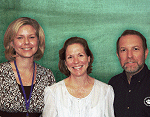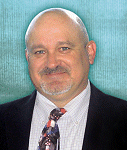THE Journal's 2007 Innovators : 5
Linda McVay, Linda DeSpain, Diane Fenly, and Becki Teague
Edmond Public Schools (OK)
 Just north of Oklahoma City, Edmond Public Schools—comprising 20,000 students across 16 elementary, five middle,and three high schools—always considered itself atop-notch district. But in 2005 it was listed on the state'sSchool Improvement List for failing to make sufficient yearlyprogress in reading. Upon investigating, administratorsdiscovered that special education scores were bringing theiroverall average down, and they immediately took action to dosomething about it.
Just north of Oklahoma City, Edmond Public Schools—comprising 20,000 students across 16 elementary, five middle,and three high schools—always considered itself atop-notch district. But in 2005 it was listed on the state'sSchool Improvement List for failing to make sufficient yearlyprogress in reading. Upon investigating, administratorsdiscovered that special education scores were bringing theiroverall average down, and they immediately took action to dosomething about it.
The district hired a literacy coach, Linda McVay, and developed and launched the Special Education Reading Initiative, the core of which provides special education students in all grades with individualized, webbased programs in reading and mathematics. A cadre of dedicated educators—McVay, Associate Superintendent Linda DeSpain, IT consultant Diane Fenly, and Coordinator of Instructional Technology Becki Teague—started implementation where the need was the greatest. They began to use Pearson Digital Learning's SuccessMaker— 3,300 hours of standards-based reading and math curricula—with special education students in grades K to 5 (later with kids in grades 6 to 8), and Autoskill's Academy of Reading program with special ed students in grades 9 to 12.
 They put three computers in every "mild" special ed classroom and two computers in every "moderate" classroom. McVay says they target 10 to 15 minutes a day of individualized instruction for elementary school students, and a little more than that for higher grades. "I think we're getting a pretty good bang for the time we're putting in it," she says.
They put three computers in every "mild" special ed classroom and two computers in every "moderate" classroom. McVay says they target 10 to 15 minutes a day of individualized instruction for elementary school students, and a little more than that for higher grades. "I think we're getting a pretty good bang for the time we're putting in it," she says.
Indeed they are. All categories of special education, including autistic students, have shown improvement in both reading and math skills. The school is no longer on the dreaded School Improvement List. Documentation of past success is being used to support continued use of the programs. The group emphasizes training, monitoring, and feedback. "We have to work the program," Fenly says, not implement it and forget about it.
Teachers and students alike are reveling in their success. McVay recalls a ninth-grade special education student walking into class all smiles. "I understood my social studies test today," the student said, and immediately got hugs for her achievement. Not that long before, she'd been reading at a first-grade level.
Christine Young, Stephanie Branson, and Alan David
Spalding Drive Charter Elementary School (GA)
 What technology-supported, project-based learning strategiescan be leveraged to engage Title I students and provide adequatesupport to English language learners? A couple of yearsago, educators at Spalding Drive Charter ElementarySchool in Sandy Springs, GA, asked themselves this veryquestion, and after much effort came up with an answer. Under the leadership of Principal Christine Young, IT specialistAlan David, and technology teacher Stephanie Branson, theSpalding Drive Digital Studio was born.
What technology-supported, project-based learning strategiescan be leveraged to engage Title I students and provide adequatesupport to English language learners? A couple of yearsago, educators at Spalding Drive Charter ElementarySchool in Sandy Springs, GA, asked themselves this veryquestion, and after much effort came up with an answer. Under the leadership of Principal Christine Young, IT specialistAlan David, and technology teacher Stephanie Branson, theSpalding Drive Digital Studio was born.
"The program began with a few digital cameras, printers, and printing supplies purchased through a Best Buy Teach Award grant," David says. In 2006-2007, a Technology for Teaching grant from Hewlett-Packard made additional equipment available to school staff. Charter school funding and Spalding Charter School Foundation fundraisers enabled the school to purchase 28 interactive whiteboards, 30 projection devices, six mini-DV cameras, and a good stock of digital still cameras and photo printers. Along with outfitting individual classrooms, equipment was used to create a mobile digital imaging lab.
Thanks to these efforts, students and faculty regularly use video production, digital imaging, and video streaming to enrich and enliven their lessons. Typical student activities include using digital photography and video cameras to document work, create portfolios, and create visual projects for presentations that showcase their learning, while teachers use images and video clips to capture students' attention and illustrate complex concepts for English language learners. In addition, fourth- and fifth-grade students produce a weekly television program that is broadcast to the entire school, and participate in technology mini-courses, such as web page design and podcasting.
"The Digital Studio program is resulting in a number of benefits, such as students' taking increased ownership of their education and learning to work collaboratively," says David, adding that students are demonstrating noticeable improvement in concrete subject matter as well. "We are seeing growth in students' academic skills in writing, language arts, and oral communication."
To garner even more support for technology initiatives and community endeavors, increased parent participation is a priority this year. By attending Spalding's Parent University, a weekly series of workshops designed to teach parents about supporting their children's schoolwork, parents have opportunities to try out the innovations and see what they can do to improve their kids' academic performance and motivation.
Brian Dawson
Christa McAuliffe Middle School (FL)
 Science was added to the Florida Comprehensive AssessmentTest (FCAT) for eighth-graders in 2006, with dismal results.Statewide, just 32 percent of eighth-graders notched a passingscore of 3 (out of 5) on the science exam, and in TheSchool District of Palm Beach County the number was onlya few ticks higher: 35 percent. Enter Brian Dawson, a scienceteacher at Palm Beach County's Christa McAuliffe MiddleSchool. Dawson believed that the effective use of digitalportfolios would engage students and raise test scores. Toprove it, he developed andlaunched the Animate to Educateprogram.
Science was added to the Florida Comprehensive AssessmentTest (FCAT) for eighth-graders in 2006, with dismal results.Statewide, just 32 percent of eighth-graders notched a passingscore of 3 (out of 5) on the science exam, and in TheSchool District of Palm Beach County the number was onlya few ticks higher: 35 percent. Enter Brian Dawson, a scienceteacher at Palm Beach County's Christa McAuliffe MiddleSchool. Dawson believed that the effective use of digitalportfolios would engage students and raise test scores. Toprove it, he developed andlaunched the Animate to Educateprogram.
Dawson began by piloting the program with the school's gifted students in grades 6 to 8. Using Adobe's Studio 8 suite of applications, along with Microsoft's GIF Animator and PowerPoint, students combined web design and animation to develop online portfolios of science projects that demonstrated each student's grasp of key scientific concepts. The appeal of this approach to documenting mastery of science skills was readily evident: Students quickly learned the applications' basics, and then started enhancing their portfolio entries as they discovered additional features of the software.
In fact, this voluntary exploration of software features led to unexpected program dividends. "Peer instruction became an important part of Animate to Educate," Dawson says. "I didn't build it into the original design, but students took it upon themselves to help one another. This led to increased self-confidence with the tools and even more unique projects than I would have predicted." Students also became major players in maintaining the digital portfolios. "Once we got going, it wasn't long before maintenance of the pages where portfolio projects were posted became overwhelming," Dawson says. "I trained several of the more advanced students to help me keep up with it all." (Sample projects are viewable here.)
All this hard work is paying off. Eighty-five percent of the eighth-graders at Christa McAuliffe Middle School scored 3 or higher on the 2007 science assessment, and Dawson is sharing Animate to Educate with other educators. "I'm glad to have the chance to share our successes," he says, "and demonstrate the skills my students are learning."
This article originally appeared in the 12/01/2007 issue of THE Journal.